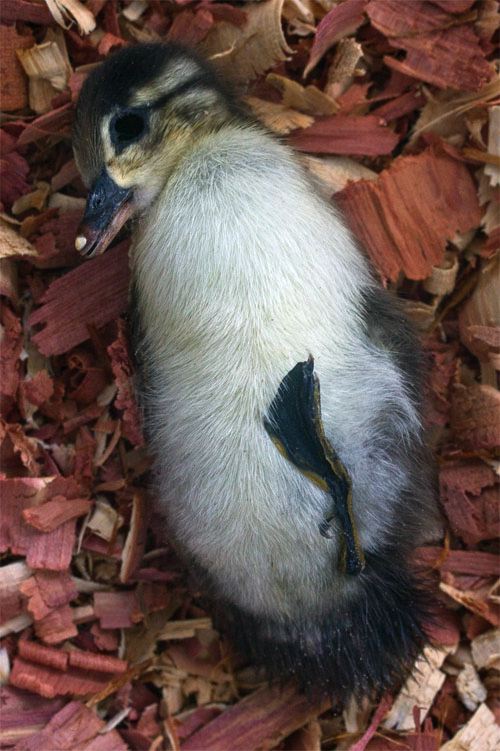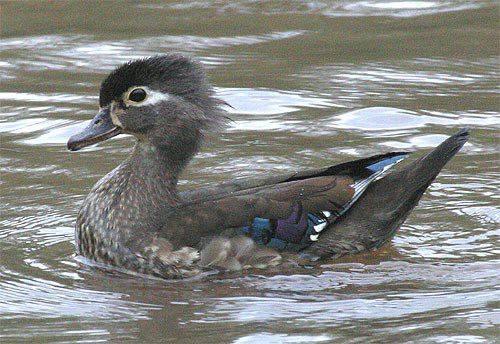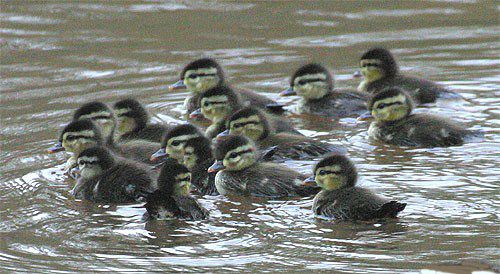|
|
|||
|
(Back to Preceding Week; on to Next Week) |
|
|
|
All text & photos © Hilton Pond Center MIDSUMMER BLUEBIRDS About three weeks ago we saw a banded male Eastern Bluebird (above) investigating a nearly worn-out nest box near the kitchen window of our old farmhouse at Hilton Pond Center. Despite intending to check the box that day for nesting activity, we forgot, and due to travel and other diversions the box went unexamined until earlier this week when we spotted a male bluebird gathering big brown beetles in the front yard and then flying toward the box in question. Any bluebird repeatedly grabbing but not swallowing big insects is a good sign there are hungry nestlings somewhere, so we weren't too surprised upon opening the kitchen nest box to find it chock full of Eastern Bluebird chicks. There were four of them (below), all about ten days old.
All text & photos © Hilton Pond Center This particular nestbox, mounted on a five-foot-tall iron pipe at the edge of a small clearing, is made from unstained Western White Cedar and has been in place for at least ten years.
All text & photos © Hilton Pond Center We thought the banded male Eastern Bluebird at the kitchen box might have been associated previously with a different artificial cavity at the entrance to the Center's driveway about 50 yards away; that location is used each year by a edgy female bluebird that flees the box every time we walk past it to get the mail or daily newspaper. Her clutch is almost always successful, however, and this year she and her mate fledged five youngsters back in very early June. It's not uncommon for Eastern Bluebirds to double- or even triple-brood in the Carolina Piedmont, hence our suspicion current activity at the kitchen nest box might involve the pair that had already used the driveway nest. Although the banded male now at the kitchen nest box might have been at the driveway nest the female certainly wasn't the spooky one--as we determined when we sat on a stool 30 feet away while she made repeated visits with pale green caterpillars (above) and other tasty morsels. Attentive parents suggest this nest box will yield four healthy bluebird fledglings within the next several days.
All text & photos © Hilton Pond Center About the same time we were investigating and photographing the kitchen nest box we noticed some other Eastern Bluebird activity down at Hilton Pond itself. Specifically, a different bluebird pair was frantically flying around a Wood Duck nest box on the near bank of the pond. Because the hole faces toward the water and away from our office window, we couldn't tell exactly what was going on, but we suspected a bluebird pair had taken over the oversized box after Wood Ducks had used it and moved out much earlier in the spring. Suitable nesting cavities are at a premium in the natural world, so having bluebirds in a Wood Duck box wouldn't be surprising--especially because Great Crested Flycatchers (above) had used one such box on Hilton Pond in past years.
All text & photos © Hilton Pond Center It took us a while to get around to checking the duck box where we saw bluebird activity that continued for two days. After all, it WAS very hot AND we had to find the boat oar, untie our floating dock (above) from the Hilton Pond pier, and paddle all the way back across the impoundment to get to the #4 duck box that stands on a pole in several feet of water. By the time we were able to do a box check no bluebirds were in attendance, so we anticipated we might find an empty bluebird nest. Instead, when we opened the hinged door on the side of the box we encountered the unexpected: A partly eaten, partly mummified, headless body of female Wood Duck! Once before when we checked a duck box in midsummer we found a fully decomposed body of a female woodie, which isn't all that surprising. We suspect in both cases the birds had simply died from the stress of laying a dozen eggs or more combined with having to incubate for three weeks AND getting less than optimal nutrition during that time. The mysterious part was this new female was headless, with no signs in the box of her bill or any skull bones. Had some predator--perhaps one of our Red-shouldered Hawks--ripped off the duck's head as she stuck it out through the nest box opening? Who knows? But the headless female Wood Duck wasn't the biggest mystery of them all. As we dug through the red cedar chips in the bottom of the nest box, we found nine unhatched duck eggs that were badly discolored, Despite this conundrum, neither of these two mummies--one hen and one duckling--turned out to be really big surprises, but when we reached into the fourth corner of the Wood Duck box we were truly astonished. Yes, neither the Our final discovery turned out to be another duckling (below), but this one was in almost pristine shape, untouched by flies or other insects, with webbed feet, a perfect covering of down, and a little white egg tooth at the tip of its bill. This Wood Duckling couldn't have been dead more than a day or two, and that's the REAL mystery--or mysteries--of the bluebirds and the Wood Duck box.
All text & photos © Hilton Pond Center What had happened here? First, had the undecomposed duckling hatched out just a few days earlier that we found it--and without a living female to incubate the egg? That seemed entirely possible, since unusually warm June temperatures could have been high enough to keep the egg viable despite the absence of an attentive hen. And second, why hadn't this apparently healthy duckling jumped from the box into the water as Wood Ducklings normally do after hatching? Well, under normal conditions a female Wood Duck (below) hangs around close beneath the nesting cavity, chirping repeatedly as encouragement for her just-hatched offspring to take their initial dives into unfamiliar waters. We hypothesize that with no hen to encourage the leap this one chick that somehow survived its siblings and its mother simply stayed in the box and finally starved to death.
So how does all this relate to the Eastern Bluebirds that had been fluttering around the Wood Duck nest box a couple of days previous to our discovery? Here's another hypothesis: The newly hatched duckling was still alive on those days and was making plaintive chirps and peeps that attracted the attention of the songbirds, all of which we suspect are genetically programmed to respond in general to sounds of baby birds under stress. A vocal Wood Duckling unnerved the Eastern Bluebirds and kept their attention, but the pair wasn't able to make the right mother duck noises to get the duckling to leave the box. We can think of one or two other possible explanations for our perplexing Wood Duck-Bluebird scenario, but as often happens in nature, new discoveries simply lead to more questions. It's nice to think we understand what we encounter, but to be honest we'll never know the true solution to this complicated Wood Duck mystery that resulted from a chance observation of agitated Eastern Bluebirds. All text & photos © Hilton Pond Center
|


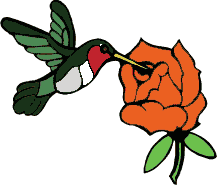 "HUMMINGBIRD MORNINGS"
"HUMMINGBIRD MORNINGS"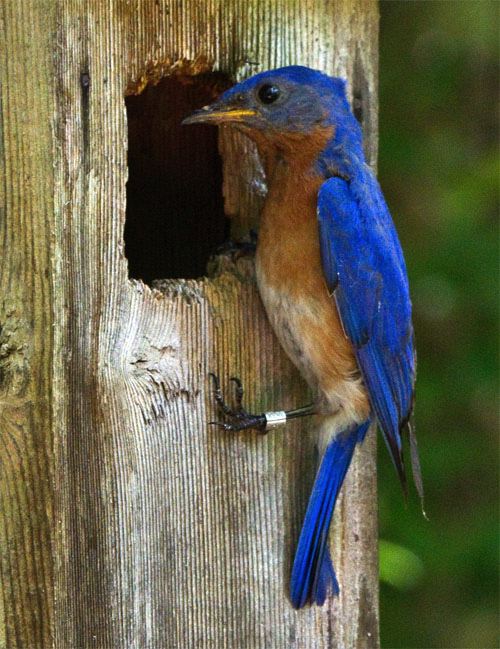
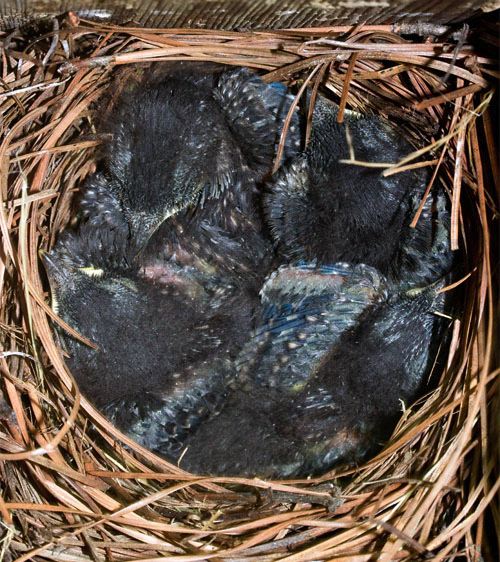
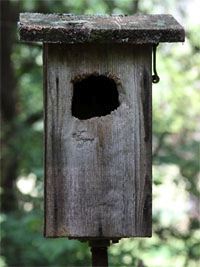 As shown in the photo at right, the 1.5" diameter entry hole--optimal for Eastern Bluebirds--has been enlarged considerably by gnaw-happy Eastern Gray Squirrels, but that hasn't stopped Carolina Chickadees from using it most years. When a chickadee pair moved in early this spring but never produced eggs, we waited a few weeks and removed their empty nest to free up the box for new tenants. Sometime after that the current occupants found the now-vacant kitchen next box, liked it, installed a lining of fresh, clean pine needles, and got down to the business of raising a bluebird family.
As shown in the photo at right, the 1.5" diameter entry hole--optimal for Eastern Bluebirds--has been enlarged considerably by gnaw-happy Eastern Gray Squirrels, but that hasn't stopped Carolina Chickadees from using it most years. When a chickadee pair moved in early this spring but never produced eggs, we waited a few weeks and removed their empty nest to free up the box for new tenants. Sometime after that the current occupants found the now-vacant kitchen next box, liked it, installed a lining of fresh, clean pine needles, and got down to the business of raising a bluebird family.
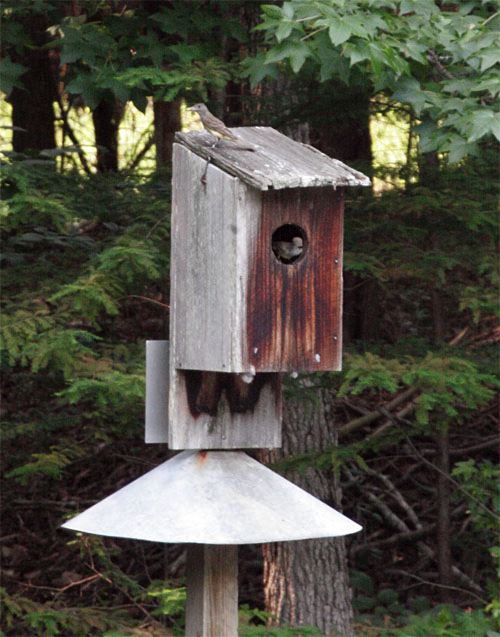
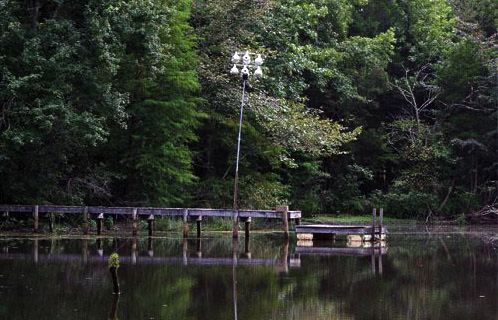
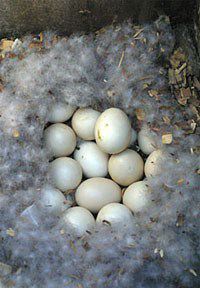 a sure sign the embryos died--perhaps after the hen had perished. Digging further we next found a baby duck that had hatched but for some reason had not gotten out of the box. Like its mother, the duckling was desiccated and mummified--nothing but feathers, skin and bones. We'd never seen this before, but--again--it wasn't a surprise; some ducklings undoubtedly succumb from the exhaustion of breaking free from the eggshell. The real question was how this duckling was able to hatch if the other eggs didn't. Hmmm.
a sure sign the embryos died--perhaps after the hen had perished. Digging further we next found a baby duck that had hatched but for some reason had not gotten out of the box. Like its mother, the duckling was desiccated and mummified--nothing but feathers, skin and bones. We'd never seen this before, but--again--it wasn't a surprise; some ducklings undoubtedly succumb from the exhaustion of breaking free from the eggshell. The real question was how this duckling was able to hatch if the other eggs didn't. Hmmm.